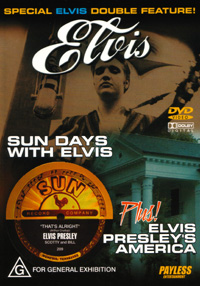The Sun Days With Elvis
Video

ElvisNews review
Design
The cover is well designed and has everything this DVD contains, SUN, Elvis and Elvis' America. The menu of the DVD is very ugly, some screenshots to jump to the chapters in awful quality. Unfortunately the image quality of the DVD itself is bad, very dark and the audio contains a lot of noise. It really is a shame that this medium is spoiled with this poor quality, it’s about the worst we have seen on DVD. The first documentary has several chapters so you can navigate through the content, the second documentary hasn't.
Content
The actual content of the DVD are two old (TV) documentaries. The first one is Elvis Presley's America from about 1990 telling the story of Elvis life primary on the pilgrimage of (a lot of) British Elvis Presley fans visiting Memphis an Tupelo. We see a lot of Elvis places Tupelo which look real shabby, even back in the eighties. We also see a lot of fans, Ricky Nelson, Joan Deary and even The Colonel in Elvis birth house in Tupelo.
Besides Tupelo Memphis was visited by the fans too of course. From the Libertyland amusement park, the SUN studio, American Sound Studio, Beale Street (with Lanky's store in stead of Elvis Presley's Memphis which is located there these days. Memphis ends with the Fort Lauderdale Courts, with people still living there.
From here we go to Hollywood, where we get to see some of Elvis houses and the Elvis star on the Walk of Fame. The camera crew lost the fans there since we don't see a single one. Up next is Nashville, Studio B of course.
Back to Memphis, finally Graceland, building, the planes and all we know. Not too many documentaries get to film inside Graceland so this is a nice tour of the building.
The second one is "SUN Days With Elvis" with Marion Keisker and Sam Philips. This documentary is more about them than about Elvis. But it's good to hear the story behind the famous SUN studio and Elvis first start from the people who were there, Sam Philips and Marion Keisker. Also there was George Klein sharing some of his memories on Elvis and the first broadcast of "That's All Right Mama", and Rufus Thomas on a white guy, Elvis, playing the blues. Wink Martindale paint a picture of the kind of music the white and black radio stations played.
This documentary contains some great fifties footage in colour and Elvis visiting George Klein in the studio. Those are the highlight behind the story we all know that told by the persons who were there.
Conclusion
Overall we get depressed from the documentary, both from the fact that a lot of Elvis places are run down now, and the poor quality of the image. This is not DVD worthy. But what can you expect from an company named "Payless Entertainment" ... Our conclusion is simple, if you have the video of this documentary (which by itself isn't bad) keep your money in your pocket or wait for a sale.
